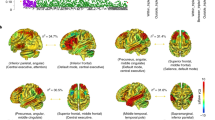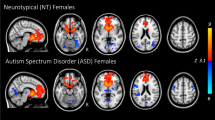Abstract
A common variant (rs53576, G/A) in the oxytocin receptor (OXTR) gene is associated with individual differences in social behavior and may increase the risk for neuropsychiatric disorders characterized by social impairment, especially autism. Although recent functional magnetic resonance imaging (fMRI) studies have identified functional connectivity alteration in some brain regions in risk A allele carriers, it is currently unknown whether this dysfunctional connectivity causes disruption of the topological properties of brain functional networks. We applied a graph-theoretical analysis to investigate the topological properties of brain networks derived from resting-state fMRI in relation to AA homozygotes versus G allele carriers in 290 cognitive normal young adults. We found both AA homozygotes and G allele carriers demonstrated small-world properties; however, male AA homozygotes showed lower normalized clustering coefficient, small-worldness, and local efficiency compared with male G allele carriers, no differences survived after Bonferroni correction; and the inter-group differences of all three metrics exhibited an allele-load-dependent trend (AA < AG < GG), indicating a randomization shift of their brain functional networks. No significant results were observed in any global measures in female AA homozygotes as compared to female G allele carriers. Our results suggested that the topological patterns of brain functional networks were altered in OXTR rs53576 male homozygotes for the risk A allele compared with male G allele carriers, providing evidence for the disruption of integrity in large-scale intrinsic brain networks in a sex-dimorphic manner.



Similar content being viewed by others
References
Feldman R, Monakhov M, Pratt M, Ebstein RP (2016) Oxytocin pathway genes: evolutionary ancient system impacting on human affiliation, sociality, and psychopathology. Biol Psychiatry 79:174–184
Guastella AJ, Hickie IB (2016) Oxytocin treatment, circuitry, and autism: a critical review of the literature placing oxytocin into the autism context. Biol Psychiatry 79:234–242
Gimpl G, Fahrenholz F (2001) The oxytocin receptor system: structure, function, and regulation. Physiol Rev 81:629–683
Haram M, Tesli M, Bettella F, Djurovic S, Andreassen OA et al (2015) Association between genetic variation in the oxytocin receptor gene and emotional withdrawal, but not between oxytocin pathway genes and diagnosis in psychotic disorders. Front Hum Neurosci 9:9
Bakermans-Kranenburg MJ, van Ijzendoorn MH (2008) Oxytocin receptor (OXTR) and serotonin transporter (5-HTT) genes associated with observed parenting. Soc Cogn Affect Neurosci 3:128–134
Rodrigues SM, Saslow LR, Garcia N, John OP, Keltner D (2009) Oxytocin receptor genetic variation relates to empathy and stress reactivity in humans. Proc Natl Acad Sci USA 106:21437–21441
Kim HS, Sherman DK, Sasaki JY, Xu J, Chu TQ et al (2010) Culture, distress, and oxytocin receptor polymorphism (OXTR) interact to influence emotional support seeking. Proc Natl Acad Sci USA 107:15717–15721
Lucht MJ, Barnow S, Sonnenfeld C, Rosenberger A, Grabe HJ et al (2009) Associations between the oxytocin receptor gene (OXTR) and affect, loneliness and intelligence in normal subjects. Prog Neuropsychopharmacol Biol Psychiatry 33:860–866
Chen FS, Johnson SC (2012) An oxytocin receptor gene variant predicts attachment anxiety in females and autism-spectrum traits in males. Soc Psychol Personal Sci 3:93–99
Wu N, Li Z, Su Y (2012) The association between oxytocin receptor gene polymorphism (OXTR) and trait empathy. J Affect Disord 138:468–472
Tost H, Kolachana B, Hakimi S, Lemaitre H, Verchinski BA et al (2010) A common allele in the oxytocin receptor gene (OXTR) impacts prosocial temperament and human hypothalamic-limbic structure and function. Proc Natl Acad Sci USA 107:13936–13941
Saphire-Bernstein S, Way BM, Kim HS, Sherman DK, Taylor SE (2011) Oxytocin receptor gene (OXTR) is related to psychological resources. Proc Natl Acad Sci USA 108:15118–15122
Wu S, Jia M, Ruan Y, Liu J, Guo Y et al (2005) Positive association of the oxytocin receptor gene (OXTR) with autism in the Chinese Han population. Biol Psychiatry 58:74–77
Wang J, Qin W, Liu B, Wang D, Zhang Y et al (2013) Variant in OXTR gene and functional connectivity of the hypothalamus in normal subjects. Neuroimage 81:199–204
Wang J, Qin W, Liu B, Zhou Y, Wang D et al (2014) Neural mechanisms of oxytocin receptor gene mediating anxiety-related temperament. Brain Struct Funct 219:1543–1554
Drakesmith M, Caeyenberghs K, Dutt A, Lewis G, David AS et al (2015) Overcoming the effects of false positives and threshold bias in graph theoretical analyses of neuroimaging data. Neuroimage 118:313–333
Colon-Perez LM, Couret M, Triplett W, Price CC, Mareci TH (2016) Small worldness in dense and weighted connectomes. Front Phys. https://doi.org/10.3389/fphy.2016.00014
Huang H, Shu N, Mishra V, Jeon T, Chalak L et al (2015) Development of human brain structural networks through infancy and childhood. Cereb Cortex 25:1389–1404
Baron-Cohen S, Knickmeyer RC, Belmonte MK (2005) Sex differences in the brain: implications for explaining autism. Science 310:819–823
Achard S, Bullmore E (2007) Efficiency and cost of economical brain functional networks. PLoS Comput Biol 3:e17
Fox MD, Zhang D, Snyder AZ, Raichle ME (2009) The global signal and observed anticorrelated resting state brain networks. J Neurophysiol 101:3270–3283
Liu F, Guo W, Fouche JP, Wang Y, Wang W et al (2015) Multivariate classification of social anxiety disorder using whole brain functional connectivity. Brain Struct Funct 220:101–115
Lei D, Li K, Li L, Chen F, Huang X et al (2015) Disrupted functional brain connectome in patients with posttraumatic stress disorder. Radiology 276:818–827
Suo X, Lei D, Li K, Chen F, Li F et al (2015) Disrupted brain network topology in pediatric posttraumatic stress disorder: a resting-state fMRI study. Hum Brain Mapp 36:3677–3686
van den Heuvel MP, de Lange SC, Zalesky A, Seguin C, Yeo BTT et al (2017) Proportional thresholding in resting-state fMRI functional connectivity networks and consequences for patient-control connectome studies: issues and recommendations. Neuroimage 152:437–449
Grabow C, Grosskinsky S, Kurths J, Timme M (2015) Collective relaxation dynamics of small-world networks. Phys Rev E Stat Nonlin Soft Matter Phys 91:052815
Rubinov M, Sporns O (2010) Complex network measures of brain connectivity: uses and interpretations. Neuroimage 52:1059–1069
Zhang J, Wang J, Wu Q, Kuang W, Huang X et al (2011) Disrupted brain connectivity networks in drug-naive, first-episode major depressive disorder. Biol Psychiatry 70:334–342
Murphy K, Birn RM, Handwerker DA, Jones TB, Bandettini PA (2009) The impact of global signal regression on resting state correlations: are anti-correlated networks introduced? Neuroimage 44:893–905
Fornito A, Zalesky A, Bullmore ET (2010) Network scaling effects in graph analytic studies of human resting-state FMRI data. Front Syst Neurosci 4:22
Zalesky A, Fornito A, Harding IH, Cocchi L, Yucel M et al (2010) Whole-brain anatomical networks: does the choice of nodes matter? Neuroimage 50:970–983
Yao Z, Hu B, Xie Y, Moore P, Zheng J (2015) A review of structural and functional brain networks: small world and atlas. Brain Inform 2:45–52
Achard S, Salvador R, Whitcher B, Suckling J, Bullmore E (2006) A resilient, low-frequency, small-world human brain functional network with highly connected association cortical hubs. J Neurosci 26:63–72
Bassett DS, Meyer-Lindenberg A, Achard S, Duke T, Bullmore E (2006) Adaptive reconfiguration of fractal small-world human brain functional networks. Proc Natl Acad Sci USA 103:19518–19523
Sporns O (2013) Network attributes for segregation and integration in the human brain. Curr Opin Neurobiol 23:162–171
Alexander-Bloch AF, Gogtay N, Meunier D, Birn R, Clasen L et al (2010) Disrupted modularity and local connectivity of brain functional networks in childhood-onset schizophrenia. Front Syst Neurosci 4:147
Caeyenberghs K, Taymans T, Wilson PH, Vanderstraeten G, Hosseini H et al (2016) Neural signature of developmental coordination disorder in the structural connectome independent of comorbid autism. Dev Sci 19:599–612
Liu F, Zhuo C, Yu C (2016) Altered cerebral blood flow covariance network in schizophrenia. Front Neurosci 10:308
Lo CY, Wang PN, Chou KH, Wang J, He Y et al (2010) Diffusion tensor tractography reveals abnormal topological organization in structural cortical networks in Alzheimer's disease. J Neurosci 30:16876–16885
Wang Z, Yuan Y, Bai F, You J, Zhang Z (2016) Altered topological patterns of brain networks in remitted late-onset depression: a resting-state fMRI study. J Clin Psychiatry 77:123–130
Barttfeld P, Wicker B, Cukier S, Navarta S, Lew S et al (2011) A big-world network in ASD: dynamical connectivity analysis reflects a deficit in long-range connections and an excess of short-range connections. Neuropsychologia 49:254–263
Peters JM, Taquet M, Vega C, Jeste SS, Fernandez IS et al (2013) Brain functional networks in syndromic and non-syndromic autism: a graph theoretical study of EEG connectivity. BMC Med 11:54
Rudie JD, Brown JA, Beck-Pancer D, Hernandez LM, Dennis EL et al (2012) Altered functional and structural brain network organization in autism. Neuroimage Clin 2:79–94
Zeng K, Kang J, Ouyang G, Li J, Han J et al (2017) Disrupted brain network in children with autism spectrum disorder. Sci Rep 7:16253
Carter CS (2007) Sex differences in oxytocin and vasopressin: implications for autism spectrum disorders? Behav Brain Res 176:170–186
de Vries GJ (2008) Sex differences in vasopressin and oxytocin innervation of the brain. Prog Brain Res 170:17–27
Rilling JK, Demarco AC, Hackett PD, Chen X, Gautam P et al (2014) Sex differences in the neural and behavioral response to intranasal oxytocin and vasopressin during human social interaction. Psychoneuroendocrinology 39:237–248
Wang J, Braskie MN, Hafzalla GW, Faskowitz J, McMahon KL et al (2017) Relationship of a common OXTR gene variant to brain structure and default mode network function in healthy humans. Neuroimage 147:500–506
Domes G, Lischke A, Berger C, Grossmann A, Hauenstein K et al (2010) Effects of intranasal oxytocin on emotional face processing in women. Psychoneuroendocrinology 35:83–93
Murata T, Murata E, Liu CX, Narita K, Honda K et al (2000) Oxytocin receptor gene expression in rat uterus: regulation by ovarian steroids. J Endocrinol 166:45–52
Bakermans-Kranenburg MJ, van Ijzendoorn MH (2014) A sociability gene? Meta-analysis of oxytocin receptor genotype effects in humans. Psychiatr Genet 24:45–51
Funding
This work was supported by the Natural Science Foundation of China (Grant nos. 81871431, 81301201 and 81271551), the Natural Science Foundation of Tianjin Municipal Science and Technology Commission (Grant Nos. 18JCYBJC26300 and 18JCQNJC10900) and 2017 "New Century" Talent Training Project of Tianjin Medical University General Hospital.
Author information
Authors and Affiliations
Contributions
Guarantors of integrity of the entire study: JW and FL; study concepts/study design or data acquisition or data analysis/ interpretation: all authors; manuscript drafting for important intellectual content: all authors; approval of final version of submitted manuscript: all authors; literature research, JW, YZ, ZY, DZ, FL, and WQ; clinical studies, JZ and BL; experimental studies, WQ, JZ, and BL; statistical analysis, JW, YZ, ZY, DZ, FL, and WQ.
Corresponding authors
Ethics declarations
Conflict of interest
All the authors declare that they have no competing interests.
Ethical approval
All procedures performed in our studies involving 324 healthy young adults were in accordance with the ethical standards of Tianjin Medical University General Hospital and with the 1964 Helsinki declaration and its later amendments or comparable ethical standards. After a complete description of our study, written informed consent was obtained from all participants.
Availability of data and material
The datasets used and/or analyzed during the current study are available from the corresponding author on reasonable request.
Electronic supplementary material
Below is the link to the electronic supplementary material.
Rights and permissions
About this article
Cite this article
Wang, J., Zhang, Y., Zhu, D. et al. A common variant in OXTR rs53576 impacts topological patterns of brain functional networks. Eur Child Adolesc Psychiatry 29, 993–1002 (2020). https://doi.org/10.1007/s00787-019-01414-5
Received:
Accepted:
Published:
Issue Date:
DOI: https://doi.org/10.1007/s00787-019-01414-5




